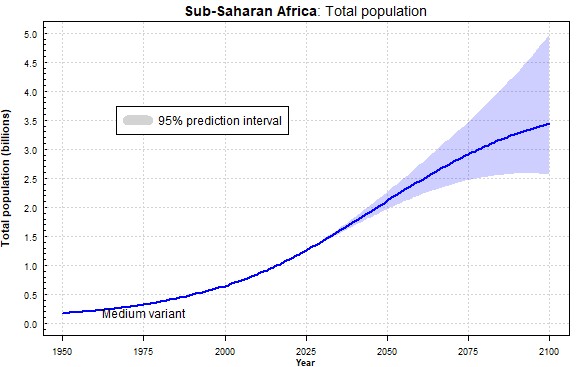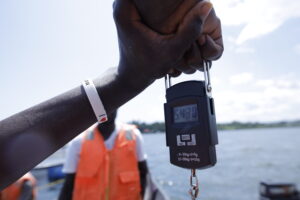The aquaculture industry in East Africa is growing rapidly on the back of the vast lakes and rivers present in the region. But whilst fish farmers are focussed on producing enough fish to match the soaring global and local demands, thriving in this cutthroat sector requires more than just farming skills. It calls for a savvy business acumen: an understanding of how, where and when to sell your fish.
Join us as we guide you through the aquaculture value chain, exploring the marketing and sales techniques that will help you build your brand, develop competitive selling points and build relationships with buyers. Armed with this know-how, you’ll be able to maximize profits and ensure your fish farming business is a success for years to come.
Discovering Aquaculture in East Africa
Sub-Saharan Africa’s rapidly growing population is increasingly demanding fish products, with Nile Tilapia and African Catfish being the most preferred due to their taste, ease of preparation, affordability, and nutritional value. However wild catch fish is becoming increasingly scarce, and aquaculture is stepping in to fill the gap. According to Gatsby Africa, the industry in East Africa has expanded between 4 to 5-fold over the past five years. This expansion is driven by new pond and cage farms starting up, but also new experienced entrants into the market like Yalelo and Victory Farms.
However, with the aquaculture sector booming, competition between fish farmers for sales has also increased. Though the overall market demand is there, meeting specific customer needs can be difficult and make it difficult to have stable, profitable sales as a farm. As such, a sound marketing and sales strategy is crucial to the success of your fish farm
From Farm to Plate: Aquaculture value chain
When we talk of the Aquaculture value chain it starts at the fish seed procedures and ends up at the final consumer; the person who eats the fish. Between these 2 points is an intricate network, a chain, that links all the different players and stakeholders together, to make sure that the fish ends up with the customer at the right time, in the right place, prepared just the way they like it. And not to forget, at the right price.
In previous publications, we have discussed various aspects of the process of producing full-grown Tilapia fishes. This month, our focus is on the equally crucial next part of the process; fish sales, or rather, the journey from farm to table.
Main links in Fish sales value chain
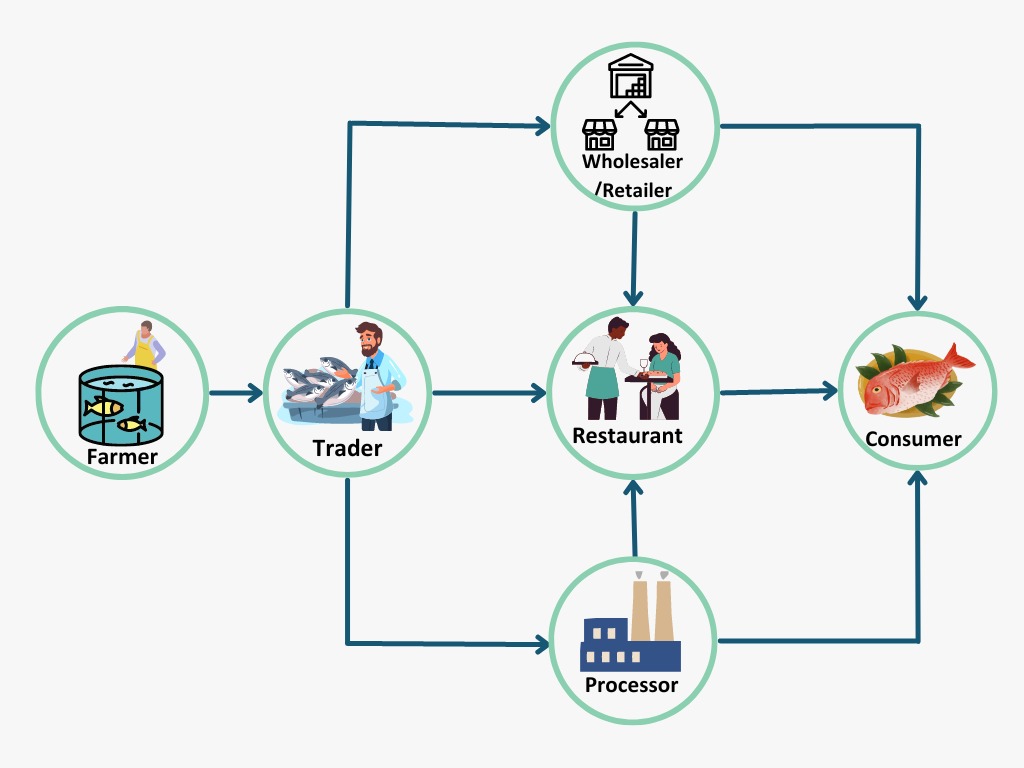
1. Fish farmer
The farmer is a specialist in producing and harvesting fish. The specifications of this fish such as fish species (e.g. Catfish or Tilapia), as well as the fish size (350g or 800g), overall quality and any special requirements (e.g. organically fed fish that has grown swimming in natural lake currents of Lake Victoria) is up to the farmer to decide. Right after harvest the fish is typically scaled and gutted at the farm to extend the shelf life and make it ready for transport and further processing.
2. Traders
In many cases individual fish farmers produce relatively small lots of fish, are geographically far and do not have the time and resources to sell directly to the next link in the chain. This is where traders come in. Traders typically deal with many farmers directly, they buy and bulk fish from several farmers to make a lot of sufficient size and then sell the big lot of fish onwards to either processors or wholesalers, nationally or internationally. Different traders have different customers who they serve which will influence what, and when they buy from which farm and at what price. Some will for example specialize in supplying tilapia to wholesalers in Congo. As a result they will be looking for big size Tilapia for the lowest price. Others may supply exclusive restaurants in Europe with the finest African Tilapia. They will be buying from specific farms that meet their quality standards, specific size requirements depending on the restaurant, and be willing to pay a premium for the freshest produce. Again another will be supplying a fish processing plant where they tin fish. They may be buying smaller fish that other traders do not want to purchase, at the lowest price possible.
3. Processors
Fish processing has been practiced for centuries around the world, employing various methods to extend the shelf life of fish. Nowadays it is no longer as much about preservation but also very much about value addition by adding desirable traits to the product (taste, convenience, etc.). Some of the well known methods of preserving fish include:
Drying
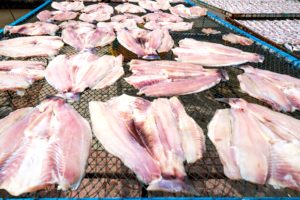
One of the oldest and most common methods, drying fish involves the fish being typically cleaned, salted, and left to dry in the sun or in a well-ventilated area. Examples include stockfish (dried cod) in Scandinavia and bagoong (fermented and sun-dried fish) in the Philippines.
Smoking
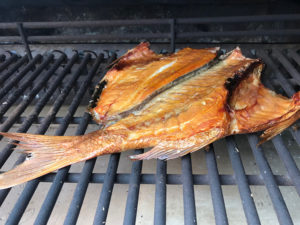
Smoking fish involves exposing them to smoke produced by burning wood or other materials. This process dries the fish, adds flavor, and creates an environment inhospitable to bacteria. Popular smoked fish products include kippers in the United Kingdom and smoked salmon in various countries.
Salting
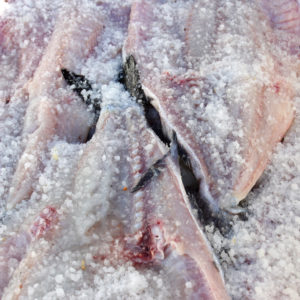
Salt acts as a preservative by drawing out moisture from the fish, inhibiting the growth of bacteria. Fish are layered with salt in barrels or containers and left to cure for a period of time. Examples include salted herring in Northern Europe and salted dried fish in many coastal regions.
Fermenting
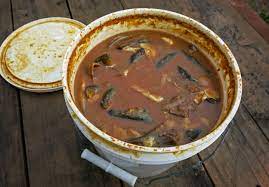
Fermentation involves the action of microorganisms on fish. The fish are typically cleaned, salted, and packed in containers, allowing natural fermentation to occur. Examples include; surströmming in Sweden and pla ra in Thailand.
Pickling
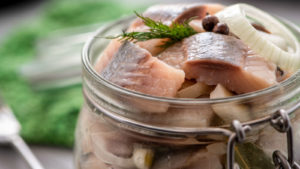
Pickling fish involves submerging them in a solution of vinegar, salt, and spices, which creates an acidic environment unfavorable for bacterial growth. Pickled herring is a well-known example in Scandinavian cuisine.
Canning

Canning is a traditional method that involves preserving fish in sealed containers, often with added oils, and sauces. The fish is sterilized inside the cans, ensuring a longer shelf life. Canned tuna and sardines are popular examples worldwide.
Freezing
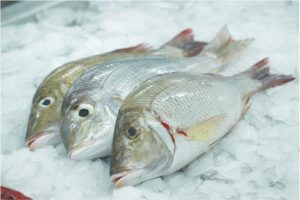
While freezing is a modern preservation method, it has been used traditionally in cold regions with access to ice and snow. Fish are cleaned, often salted, and stored in freezing temperatures to maintain their quality for an extended period.
Traditionally these fish preservation methods have been shaped by local cultures, climatic conditions, and available resources, allowing communities around the world to store and consume fish over long periods, especially in areas without easy access to fresh seafood. Though the initial reason for processing was preservation of fish, nowadays it is also to achieve specific flavors and to offer ready to eat or easy to prepare products to consumers. As such these traditions have inspired a whole range of value added fish products across the world. In East Africa the most common processing methods today still include smoking, sun-drying and salting.
The interesting thing is that processing like this is often done in different steps by different players. For example, after being purchased from the farm, the next company might filet the fish and the next can do the smoking and vacuum packing. Or others might simply assist the trader by flash freezing the product to get it ready for transport to the US. There are as many variations and links as there are products.
4. Wholesalers
Wholesalers by definition buy from and sell to businesses. They do not deal with the final consumer. Instead they are focussed on bringing products to market at a central location, and making it available where it is needed. As a result they often carry a whole range of products in a specific category. For example a seafood wholesaler may stock all sorts of tilapia products from different regions fresh whole round, frozen filets, and smoked vacuum packed), but also shrimp products, salmon and mussels. By doing so they make it easier for suppliers to bring their products to market, and at the same time for retailers and restaurants to access products from across the globe, as and when they need them.
5. Retailers
Retailers include supermarkets, specialized fish shops but also market sellers. They provide fish products directly to the final consumer.
6. Restaurants
Restaurants go one step further and provide ready to eat fish products to the consumer on the final table.
7. Consumers
At the far end of the value chain lies one crucial component – the consumer. It’s the demand from the consumer that sets the wheels in motion for this intricate system. Companies spend night and day to understand and anticipate their customers’ needs, in order to stay ahead of the game. And the consumer, in turn, shapes the value chain by the choices they make, the preferences they express, and the trends they follow. Their impact on the value chain is undeniable and puts them in the driver’s seat.
Although the value chain follows a sequence of events, one player can fulfill more than one step. Moreover, not every link is necessary for delivering fish to the consumer’s table. A farmer could, for instance, filet, smoke, and vacuum-pack their fish before direct-shipping to a restaurant in Tokyo. In contrast, the same farmer could trade some fish at a local market and sell the rest to a trader at the farmgate. Each step has specific requirements, risks, and rewards.
It’s evident that the value chain comprises varying links, each representing a unique approach to getting a product into the consumer’s hands. Nonetheless, every step presents its own benefits and challenges for farmers. Lets focus on selling whole round fish, or minimally processed fish from a farmers perspective.
| Outlet | Advantages | Disadvantages |
| Farm gate | – Easy; your buyer comes to pick the fish – Can sell any quantity; Bulk to a trader, a basket to a market lady, and/or per piece straight to consumers – Lowest investment – Fast payment on delivery – Multiple buyers | – Wait for buyers to come – Minimal negotiation on price – Lowest price – No added value in terms of processing – No uniqueness in brand value – No loyalty from the buyer |
| Market (local, regional or national) | – Access to a number of consumers – Direct access to consumers – Serve different regions – Brand is known – Higher price than farm gate – Payment on sale | – Have to time harvest with market days – You incur full cost and risk for transportation and storage – Keep having to put up your stall and move with it – Marketing required |
| Retail outlets (in a village, big city, or abroad) | – Continuous sales – Direct to consumers = build relationship = story matters – Capitalize on brand value – Highest price – Payment on sale – Offer product suited to individual customer | – High investment (coolers) and overhead (rent and salaries) – Your fish might expire before its sold – Investment in branding needed to set you apart from other shops – You incur full cost and risk for costs – Tied down to a specific location |
| Sell to a Retailer, Wholesaler, Restaurant | – Higher price the closer to consumer – Relationship value – Brand value – Continuous sales – Large/flexible customer base | – Requires continuous marketing and sales investment and skills – Investment in transportation – Incur full risk until delivery – Payment terms may be provided – Large lots often required – Certification and quality standards may be mandatory |
So, deciding which product to supply and where is a crucial decision for each farmer to make before production begins. There is no definitive answer, yet it’s vital to align your farm’s abilities and resources to the market segment. This is known as the product-market mix.
Marketing strategy: All about product-market match
As you can see there are many options to sell your fish, which all require different skills, resources and investment and come with different risks and rewards. Therefore it is important to identify your ideal customer, and then start looking for and reaching out to that person. You can only do this with a thorough understanding of the value chain, and of your own value proposition and company competencies. These reflective questions allow you to assess your capabilities, strengths, and unique selling points, enabling you to identify the customer segments who align with your values and are willing to pay a premium for your fish.
Once you have identified your ideal customer you can craft a marketing strategy. A key component of such a strategy is the marketing mix, or the 4Ps (Product, Price, Place, Promotion). It refers to the strategic combination of elements a business uses to meet target market needs.
For a fish farmer, the product-market mix involves determining the optimal specifications of their fish products – quality, variety, packaging, and any value-added options (Product) – at competitive pricing (Price). Then, identifying appropriate marketing and promotional strategies (Promotion) to interest and reach (Place) their customers. Determining the marketing mix matters for three reasons:
Targeted Marketing: It aligns the fish farmers’ products and marketing efforts with the specific needs and preferences of their target market.
Competitive Advantage: Unique or highest quality products give the fish farmer a competitive edge in the market.
Resource Optimization: By focusing on the most promising product-market combinations, farmers can efficiently utilize their production capacity and resources to maximum effect.
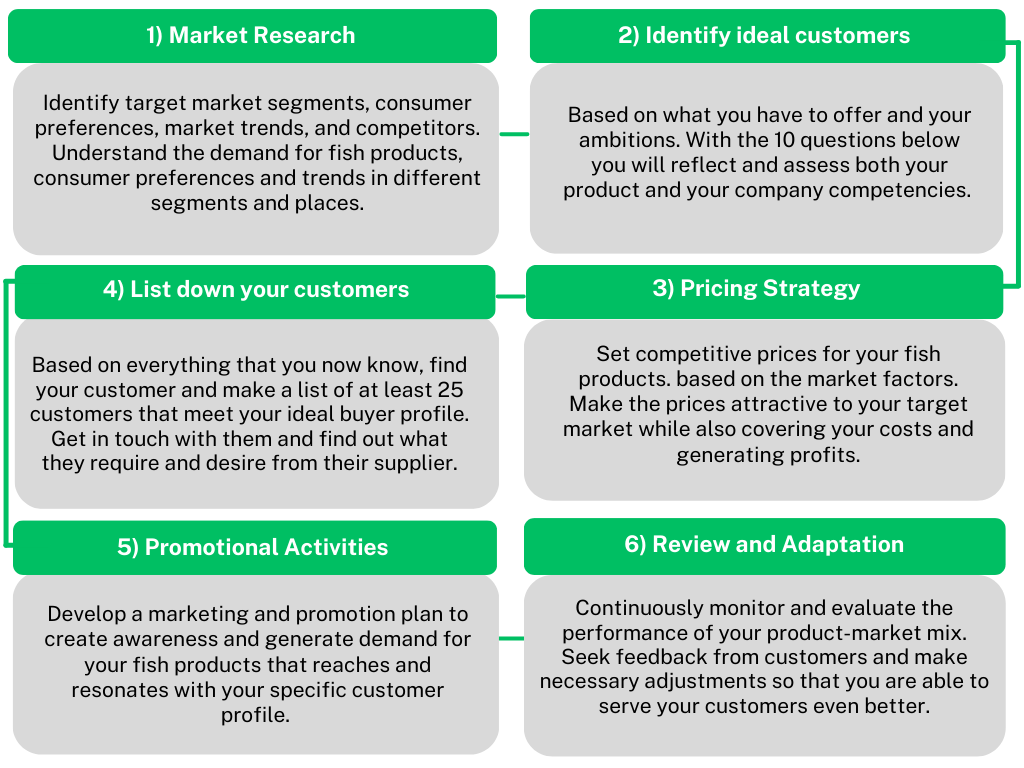
- What are the specific fish species that I excel in farming, considering factors such as growth rate, adaptability, and overall quality?
- What are the unique qualities or characteristics of my fish products that set them apart from others in the market? (e.g., exceptional taste, superior texture, sustainable farming practices, size, certifications)
- What farming methods or techniques do I specialize in that contribute to the high quality and sustainability of my fish products? (e.g., recirculating aquaculture system, organic feed)
- What is the ideal customer profile that aligns with my fish farming practices and offerings? (e.g., environmentally conscious consumers, high-end restaurants, specialty seafood retailers)
- What quantity or volume of fish products can I consistently produce without compromising quality or sustainability?
- What is a fair and competitive price range for my premium fish products, considering their unique attributes, market demand and my production cost?
- Which competencies, experience and capacity do I have on my farm (within my team) to do marketing and sales?
- How much money do I have available to invest in transport, storage and marketing?
- How can I effectively communicate and showcase my farming practices, product quality, and unique offerings to potential customers?
- What distribution channels best align with my farming capabilities and target market? (e.g., direct bulk sales from the farm, partnerships with local markets)
It is a well known fact in business that finding new customers can be 25x more expensive then it is to retain an existing one. So keep this in mind when you handle your customers. They are the lifeblood of your business.
In conclusion, determining the optimal product-market mix is vital for the success of any fish farmer in the booming aquaculture industry of East Africa. By understanding the value chain and your customer just as thoroughly as you understand your fish you can make sure you provide the most value and get the best price. Don’t forget – the customer is the lifeblood of your business and retaining their loyalty is more cost-effective than constantly seeking out new customers. Remember, it’s not just enough to produce plenty of fish – for business success, you also need a robust marketing and sales strategy.
Has this blog offered you valuable insights on how to successfully market and sell your fish products in the booming aquaculture industry of East Africa? Let us know in the comments!
Should you seek further support or have questions, don’t hesitate to reach out to the Aquaculture Support Center for expert guidance. Let’s work together to grow this industry and sustainably feed the world.


